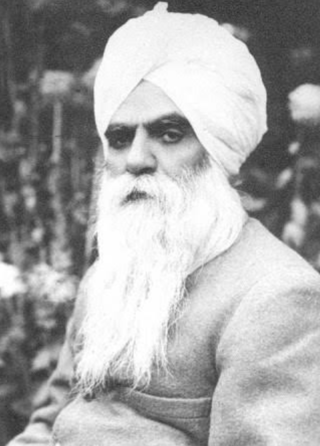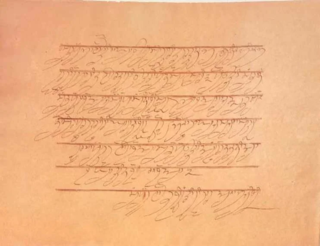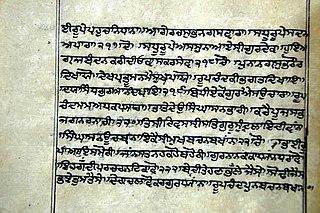
The Dasam Granth is a collection of various poetic compositions attributed to Guru Gobind Singh. The text enjoyed an equal status with the Adi Granth, or Guru Granth Sahib, in the eighteenth and nineteenth centuries and were installed side by side on the same platform. The Dasam Granth lost favor during the colonial period when reformist Singh Sabha Movement scholars couldn't contextualize the reworkings of Puranic stories or the vast collection of 'Tales of Deceit' Sri Charitropakhyan.

The Sarbloh Granth or Sarabloh Granth, also called Manglacharan Puran or Sri Manglacharan Ji, is a voluminous scripture, composed of more than 6,500 poetic stanzas. It is traditionally attributed as being the work of Guru Gobind Singh, the tenth Sikh guru. Scholars, on the other hand, attribute the work to after the Guru's death, being authored by an unknown poet. The work is mostly revered by the Nihang sect.

Bhai Vir Singh was an Indian poet, scholar, and theologian of the Sikh revival movement, playing an important part in the renewal of Punjabi literary tradition. Singh's contributions were so important and influential that he became canonized as Bhai, an honorific often given to those who could be considered a saint of the Sikh faith.

Jujhar Singh (Punjabi: ਸਾਹਿਬਜ਼ਾਦਾ ਜੁਝਾਰ ਸਿੰਘ, pronunciation: ; 9 April 1691 – 23 December 1704), the second son of Gobind Singh, was born to Mata Jito at Anandpur Sahib. This event is now celebrated on April 9 each year according to the Nanakshahi Calendar.
Sarbat Khalsa, was a biannual deliberative assembly of the Sikhs held at Amritsar in Panjab during the 18th century. It literally translates to the "entire Sikh Nation" but as a political institution it refers to the meetings of the Dal Khalsa, Sikh Misls, and the legislature of the Sikh Empire.

Chandi Di Var also known as Vaar Durga Ki is a composition written by Guru Gobind Singh, included in the 5th chapter of Dasam Granth.

Suraj Prakash, also called Gurpartāp Sūraj Granth, is a popular and monumental hagiographic text about Sikh Gurus written by Kavi Santokh Singh (1787–1843) and published in 1843 CE. It consists of life legends performed by Sikh Gurus and historic Sikhs such as Baba Banda Bahadur in 51,820 verses. Most modern writing on the Sikh Gurus finds its basis from this text.

Giani Gurdit Singh was born in Mithewal village in the state of Punjab, India. He was considered one of the greatest contemporary writers in Punjabi, and his book Mera Pind is regarded as a classic. It is now in its 14th edition and has been in print continuously since 1961. He was also a pioneering journalist, the Owner-Editor of Parkash 1947–1978. He was also the editor of Singh Sabha Patrika, a monthly magazine of Sikh history and divinity. Giani Gurdit Singh graduated as "Giani" from Punjab University, Lahore in 1945, and he specialised in literature, divinity, history and folklore. He was a member of the Punjab Legislative Council from 1956 to 1962. He contributed to the debates at that time and in the creation of Punjabi University, Patiala and the recognition of Takht Sri Damdama Sahib, Talwandi Sabo, as the 5th Takht of the Sikhs. He was General Secretary of the Singh Sabha Shatabadi Committee, Amritsar, renamed Kendriya Sri Guru Singh Sabha. As the editor of the magazine Singh Sabha Patrika, he focused on issues of importance to the Sikhs. He also established two Guru Granth Vidya Kendras, one in Chandigarh and another in Mehrauli, Delhi.

Mehtab Singh was a Sikh warrior and martyr. He was the son of Hara Singh of Mirarikot, a Sikh of the Bhangu clan.

Bhai Tara Singh Wan was an eighteenth-century Sikh martyr. He was from the village of Wan, also known as Wan Tara Singh and Dall-Wan now in Tarn Taran district tehsil Bhikhiwind of the Eastern Punjab.

Twarikh Guru Khalsa is a historical book of the Sikhs from their origin to the time when they lost the Punjab to the British. The author of the book is Giani Gian Singh.

Nirmala also known as Nirmala Saṁpardā or Nirmal Paṅth, is a Sikh sect of ascetics. According to the traditional beliefs, the Sanatan Nirmala Sikh tradition was founded by Guru Gobind Singh in late 17th century when he sent five Sikhs to Varanasi to learn Sanskrit and Vedanta texts.

Sikh sects, denominations, traditions, movements, sub-traditions, also known as sampardai in the Punjabi language, are sub-traditions within Sikhism that believe in different approaches to practicing the religion. All sampradas believe in the One Creator God typically rejecting both idol worship and caste systems. Different interpretations have emerged over time, some of which have a living teacher as the leader. The major historic traditions in Sikhism, states Harjot Oberoi, have included Udasi, Nirmala, Nanakpanthi, Khalsa, Sahajdhari, Namdhari Kuka, Nirankari and Sarvaria.
The Battle of Wan occurred in 1726 CE. It was the first major battle involving Sikhs since the execution of Banda Singh Bahadur.

Kavi Santokh Singh was a Sikh literati, poet, hagiographer, and historian. Santokh Singh was such a prolific writer that the Sikh Reference Library at Darbar Sahib Amritsar was named after him, located within the Mahakavi Santokh Singh Hall. In addition to "Great Poet" (Mahākavī) Santokh Singh was also referred to as the Ferdowsi of Punjabi literature, Ferdowsi wrote ~50,000 verses while Santokh Singh's Suraj Prakash totals ~52,000. Other scholars have thought of Santokh Singh as akin to Vyasa. Gottlieb Wilhelm Leitner in 1883 wrote that, "Santokh Singh of Kantal in the Karnal District, has rendered his name immortal" through the production of his works.

Giani Gian Singh was a 19th-century Sikh historian, literati, hagiographer, martial artist, theologian, and scholar. He wrote the works NaveenPanth Prakash and Twarikh Guru Khalsa.
The Battle of Chamkaur was fought in January 1764 by Sikh forces led by Jassa Singh Ahluwalia and Afghan forces led by Lachhmi Narain.

Panth Prakash, also called Pracīn Panth Prakash ["Old' Panth Prakash,not to be confused with "Naveen" Panth Prakash by Giani Gian Singh], is a historical text about Sikh history in the 1700s by Rattan Singh Bhangu and was completed in the early 1810s. The text's opening foundation briefly covers the lives of the ten Sikh Gurus, then traces the accomplishments of the Sikh community from 1708 to the establishment of Sikh rule in Punjab. The text provides the most comprehensive compilation of stories related to the feats of Sikh warriors in the 18th century, the evolving Sikh martial formations, and the internal power dynamics between Sikh Misl groups.

Anandpur Lipi is a calligraphic style of the Gurmukhi script associated with Guru Gobind Singh. It is commonly found among early manuscripts of the Dasam Granth scripture as the employed script.
















